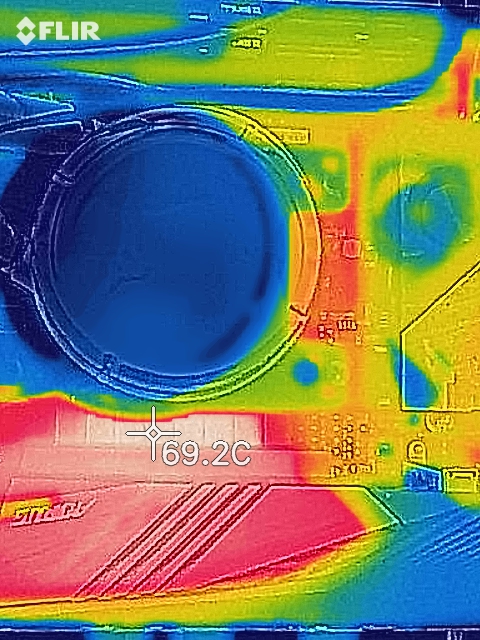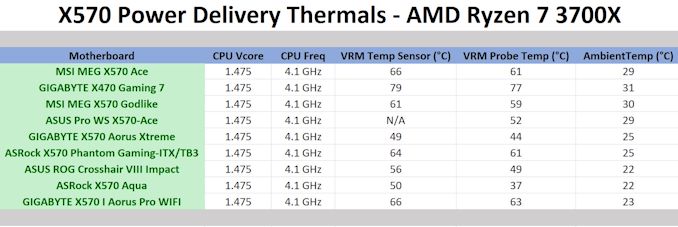On The Wings of an Eagle: GIGABYTE's X570 I Aorus Pro WIFI Motherboard Tested
by Gavin Bonshor on March 19, 2020 10:00 AM ESTPower Delivery Thermal Analysis
One of the most requested elements of our motherboard reviews revolves around the power delivery and its componentry. Aside from the quality of the components and its capability for overclocking to push out higher clock speeds which in turn improves performance, is the thermal capability of the cooling solutions implemented by manufacturers. While almost always fine for users running processors at default settings, the cooling capability of the VRMs isn't something that users should worry too much about, but for those looking to squeeze out extra performance from the CPU via overclocking, this puts extra pressure on the power delivery and in turn, generates extra heat. This is why more premium models often include heatsinks on its models with better cooling designs, heftier chunks of metal, and in some cases, even with water blocks.

The 6+2 power delivery on the GIGABYTE X570 I Aorus Pro WIFI motherboard
Testing Methodology
Out method of testing out if the power delivery and its heatsink are effective at dissipating heat, is by running an intensely heavy CPU workload for a prolonged method of time. We apply an overclock which is deemed safe and at the maximum that the silicon on our AMD Ryzen 7 3700X processor allows. We then run the Prime95 with AVX2 enabled under a torture test for an hour at the maximum stable overclock we can which puts insane pressure on the processor. We collect our data via three different methods which include the following:
- Taking a thermal image from a birds-eye view after an hour with a Flir Pro thermal imaging camera
- Securing three probes on to the rear of the PCB, right underneath CPU VCore section of the power delivery for better parity in case a probe reports a faulty reading
- Taking a reading of the VRM temperature from the sensor reading within the HWInfo monitoring application
The reason for using three different methods is that some sensors can read inaccurate temperatures, which can give very erratic results for users looking to gauge whether an overclock is too much pressure for the power delivery handle. With using a probe on the rear, it can also show the efficiency of the power stages and heatsinks as a wide margin between the probe and sensor temperature can show that the heatsink is dissipating heat and that the design is working, or that the internal sensor is massively wrong. To ensure our probe was accurate before testing, I binned 10 and selected the most accurate (within 1c of the actual temperature) for better parity in our testing.
For thermal image, we use a Flir One camera as it gives a good indication of where the heat is generated around the socket area, as some designs use different configurations and an evenly spread power delivery with good components will usually generate less heat. Manufacturers who use inefficient heatsinks and cheap out on power delivery components should run hotter than those who have invested. Of course, a $700 flagship motherboard is likely to outperform a cheaper $100 model under the same testing conditions, but it is still worth testing to see which vendors are doing things correctly.
Thermal Analysis Results

We measured 69.2°C on the hottest part of the board during our testing.
The hottest part of the heatsink was the MOSFETs
The GIGABYTE X570 I Aorus Pro WIFI is using a 6-phase power delivery for the processor with six Infineon TDA21472 70 A power stages and is controlled by an Infineon IR35201 PWM controller operating at 6+2. Cooling the board's power delivery is a small but capable heatsink which slots into the rear panel cover.
After running our VRM thermal tests, the GIGABYTE X570 I Aorus Pro WIFI performed well given the boards size in comparison to the boards we've previously tested. We observed temperatures of 66°C from the boards integrated thermal sensor, with our probes measuring 63°C attached to the rear of the power delivery. Our thermal imaging camera noted that the hottest part of the power delivery looking at the top of the board came from the MOSFETs, which we observed at just over 69°C. All our testing was done with our Ryzen 7 3700X processor and we expect the Ryzen 9 3950X processor to push the power delivery even further, and we wouldn't recommend using an overclocked 3950X in a system with this board without ensuring adequate airflow. This is due to the design of the heatsink which relies more on chassis with good airflow as opposed to a heatsink with a large mass.











63 Comments
View All Comments
wr3zzz - Thursday, March 19, 2020 - link
Same here. Don't feel like upgrading my AV setup just yet and need SPDIF. SPDIF nowadays can only be found on the highest end boards (which never include ITX or mATX) or "HTPC" boards which just means lower end chip set. I bought a sound card after more than 20 years just so in case SPDIF is gone forever if Sony chose not to keep it in PS5 as Sony is the only company keeping SPDIF alive.Flunk - Friday, March 20, 2020 - link
Many motherboards support a copper spdiff link if you plug the cable into one of the ministereo jacks and configure it in the software to digital out. You don't need a board with toslink connectors unless you're running a very long cable.a5cent - Friday, March 20, 2020 - link
ASRock X570 Phantom Gaming-ITX/TB3Has an SP/DIF port.
evernessince - Saturday, March 21, 2020 - link
SP/DIF is provided by the audio chip on the motherboard. You can add SPDIF to any motherboard with a sound card and it will be infinitely better then what you have now. I don't understand why you would limit your motherboard selection for a feature that can be added to any product on the market.RSAUser - Sunday, March 22, 2020 - link
Near any other interface would give better quality, but if it's due to older audio stuff, rather look at getting an analog to spif converter, should be around the 10-15 dollar mark, and then you'd be able to plug any device in and not have to worry about your pc not supporting it.piroroadkill - Saturday, March 21, 2020 - link
The problem is something it has.. a fanfuturepastnow - Saturday, March 21, 2020 - link
...passive coolingnerd1 - Thursday, March 19, 2020 - link
I have this board, and I hate its I/O configuration. No one will buy a x570 board to use with integrated GPU. I'd rather have USB ports (and a lot of them) AND another gigabit LAN port instead.brontes - Thursday, March 19, 2020 - link
> buys mitx> complains one (small) size does not fit all
SSTANIC - Thursday, March 19, 2020 - link
same here, identical thoughts. but it is still a very good board methinks